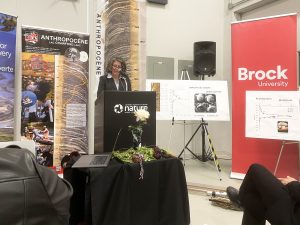A research project between universities in neighbouring countries will take a close look at the economy on both sides of the Niagara River.
Brock University’s Niagara Community Observatory and the University at Buffalo’s School of Architecture and Planning have teamed up to create a one-year research project that is taking an inventory of the two neighbouring economies.
The project aims to lay the groundwork for regional economic growth stemming from the start-up of cross-border partnerships.
“The ambition of this project is to begin to leverage Niagara’s assets as a border community, to extend the hand of partnership across the border,” says NCO Director Charles Conteh. “Both sides of the border are in economic transition. Recent reports suggest that cross-border regions are becoming more globally competitive for firms and talent.”
Collaborating with the NCO are Brock’s Goodman School of Business and the Niagara Community Foundation. UB’s School of Architecture and Planning is heading up the American research.
The bi-national team’s first workshop will take place at 4 p.m. Monday, Nov. 7 at University at Buffalo’s School of Architecture and Planning. It will focus on the life sciences sector.
“The binational team is conducting relevant economic, legal and planning research that will shed light on economic opportunities presented by virtue of the fact that we live, work, and play in a cross-border region,” says Conteh.
“Collaborating and positioning ourselves as a binational region would strengthen our position in the global marketplace,” says Kathryn Friedman, research associate professor at the UBRI and project co-coordinator.
“We would become a very attractive region for investment and economic growth,” she says.
The Cross-Border Innovation and Prosperity research project focuses on four key sectors: health/life sciences; advanced manufacturing; cultural/heritage tourism; and natural resources stewardship.
Researchers on both sides of the border will collect, map and analyze data on the Niagara, Ontario and Buffalo, New York regions’ economic strengths and weaknesses in these sectors.
The research includes holding three workshops that provincial, state, regional and municipal public sector officials, business representatives and officials from the non-profit sector from Niagara, Ontario and Buffalo Niagara.
“Although Brock and the University at Buffalo are anchoring this effort, we are truly looking for this to be a cross-sectoral, binational initiative,” says Friedman.
UB’s School of Architecture and Planning is hosting the first workshop on Nov. 7, 2016, where Conteh and other researchers will present information collected so far on the life sciences sector “to engage key stakeholders in exploring a cross-border approach to economic growth and prosperity,” says Conteh.
He explains that an economically strong and prosperous Niagara will attract and employ young people, which will help to stem the problem of youth outmigration.
A host of high-level funders are backing the initiative.
Funders include: the Social Sciences and Humanities Research Council (SSHRC)’s Borders in Globalization initiative, the Ontario Trillium Foundation, the Niagara Community Foundation, the Oishei Foundation, the Niagara Falls Bridge Commission, the Peace Bridge Authority, the Regional Municipality of Niagara, and Meridian Credit Union.
Studies have shown economic potential in the Niagaras of both countries.
According to the 2016 Buffalo Niagara Economic Guide produced by the privately funded economic development organization Invest Buffalo Niagara, “the region’s strategic location on the Canadian border is within 500 miles (800 km) of 40% of the binational population.
“Our binational gateway for commerce facilitates $78 billion in annual trade between Canada and the United States,” says the report.
The City of Welland’s Economic Development Office notes in a 2015 Community Profile that, “Welland is within… 60 percent of the North American industrial market.”
“This market area comprises three-quarters of the purchasing power of Canada and the United States,” says the study. “As well, seven of the top ten U.S. industrial states are within one day’s trucking of Welland. Welland is closer to the bulk of the U.S. market than Florida, Texas and California.”










